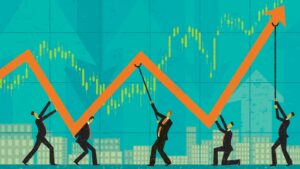Why fund managers are smarter than you think
The relative underperformance of active managers has been well documented in the last decade, and justifiably trumpeted by providers of passive investment vehicles across major markets.
The emergence of passive investments could not have been better timed, with ETFs coming to market and entering the public consciousness at a time of plenty for listed markets around the world. Since 2009, the steam has only been let out of a hot S&P 500, for example, for two relatively short bursts; one during the pandemic in 2020 and another in the tech wobble of 2022, both of which were quickly surpassed by surging market rebounds.
It’s been a terrific run for markets, which has made fund managers – who charge between 0.5 and 2.5 per cent to beat those markets – look pretty silly.
‘It has been a disaster’
In a recent quarterly outlook letter from US investment giant GMO, the group argues that fundies don’t deserve investors’ collective chagrin for their lack of performance.
Fund managers haven’t been bad at their job, GMO says. They’ve been doing the right thing. It’s just that markets have gotten… weird.
The group points to the unprecedented shape of the US stock market. The S&P 500 has become so concentrated due to the performance of the ‘Magnificent Seven’ tech stocks Apple, Meta, Nvidia, Microsoft, Tesla and Amazon and Alphabet, which now comprise about 28 per cent of the total, that it has lost value as an accurate benchmark to measure active management skill, GMO says.
The growth of these companies has far outpaced that of the average stock in the index. As active managers largely stay away from the very largest stocks in the hope of finding value, this has created an exaggerated displacement between the benchmark and the performance of stock pickers.
“For most of history, biasing portfolios against the very largest stocks has been lucrative. But over the last decade, and particularly the last year, it has been a disaster.”
“Because the vast majority of active managers are substantially underweight the largest stocks, periods when those stocks outperform are a serious headwind for active managers’ relative performance,” GMO states. “If the purpose of a benchmark is to be a fair measuring stick to determine whether a manager has skill, a market capitalization-weighted index is not a good benchmark for most active managers.”
Large cap equity benchmarks like the S&P 500 have been “close to impossible” to beat because the only way they can beat them is by looking different from it, GMO explains, which means being underweight the biggest stocks.
“Long-only active managers almost always have substantial bias against the very largest stocks in their benchmarks,” GMO continues. “For most of history, biasing portfolios against the very largest stocks has been lucrative. But over the last decade, and particularly the last year, it has been a disaster.”
The diversification reckoning
The current market isn’t just a poor marking stick for active investment expertise, GMO argues, but a dangerous one, with concentration risk at alarmingly high levels.
By any measure, the top end of the US stock market is oddly imbalanced. Here’s one metric to mull: While the top seven stocks comprised 13 per cent of the S&P 500 a decade ago, they make up 28 per cent of it now.
Growth has trounced value for almost a generation, which has warped the market into an uncomfortably concentrated position. Exacerbating the danger is that this concentration is in a single sector, one that we’ve seen turn into a catastrophic bubble as recently as 2008. A cyclical return back to value, and a dissipation of this concentration, is inevitable, GMO argues.
“Common risks across the Magnificent Seven should also be a source of unease,” GMO says, noting that they are all reliant upon the availability of semiconductors. They’re also all connected to Taiwanese electronics manufacturer Foxconn and are heavily dependent on an amiable trade relationship with both Taiwan and China.
Fund managers may have largely missed out on the rivers of gold technology stocks have brought investors, but they’re smart enough to recognise serious risk when they see it.
“If the U.S. equity market becomes less concentrated – our bet for the next decade – skilled active managers are poised to have a decade for the books,” GMO says. “Allocators who stick to basics, reminding themselves of the virtues of diversification, stand to benefit handsomely.”
For investors that continue piling into the concentrated top end of the S&P 500, the risk is highlighted by Orbis Investments. “Hope is seductive,” the Orbis team writes in its Sunrise on Venus whitepaper, “but markets can conspire to cause the greatest pain to the greatest number of investors.”
High bars are hard to hurdle
By itself, the market’s current weirdness doesn’t have to precede a precipitous fall in valuations for the Magnificent Seven. They’re all incredibly robust businesses that have either recently reinvented themselves (Microsoft, Amazon) or monopolised an industry (Apple, Alphabet, Meta, Nvidia).
“Six of the Magnificent Seven are high-quality businesses and deserve to trade at a premium,” GMO says, (adding that Tesla just “makes pretty cool cars”).
But it is going to be difficult to make money off stocks with such inflated valuations. Nvidia would need to grow by 30 per cent every year for the next five years to justify today’s stock price. This is quite possible, but would be an exceedingly rare feat; since 1990, only 45 out of 3,400 comparable stocks on the index have achieved it.
“It’s hard to exceed high expectations,” Orbis notes, pointing out that now is a dangerous time for investors to be chasing yesterday’s stock market winners.
Passive investment product providers have lived through a golden age on the back of an increasingly tight cohort of giant companies, and they may continue to do so for some time. But the arguments of fund managers – that diversification matters, and markets eventually revert – have an inevitable sense of logic, too.
Both can be right, but likely not at the same time.











